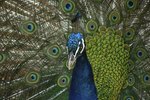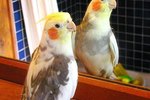Like any pet, even the best-cared-for African Grey parrot can develop health problems. Some health problems are caused by contact with other diseased pets, and some problems are due to poor breeding. Whatever the cause of your parrot's health concerns, knowing the signs of some common African Gray parrot diseases will help you deal with problems promptly.
Psittacine Beak and Feather Disease
Psittacine beak and feather disease is a common disease that affects all types of parrots, including the African Grey. A parrot affected by the disease will begin losing feathers, and the feathers that do grow in will be abnormal, according to Avian Biotech. The disease can also present symptoms such as an abnormally shaped beak or lacerations on the beak or nails. As the disease progresses, the bird will lose weight and can become depressed. Because the disease causes the bird's immune system to become compromised, other infections can occur. PBFD is transmitted through contact with droppings and feather dust of infected birds.
Proventricular Dilatation Disease
Often known as macaw wasting syndrome, Proventricular Dilatation Disease is a viral infection that affects the digestive tract of a bird. According to the International Parrot Society, it is the most common disease that kills birds that are kept as pets. The disease damages the nerve supply to the stomach, making it difficult for the bird to digest food. A bird affected by the disease will lose weight and become depressed. You will also notice that there is undigested food in your bird’s feces. In more advanced cases of the disease, the wall of the proventriculus (the glandular part of the stomach) can rupture, and food in the stomach can move into the abdominal cavity of the bird, causing bacterial infections that can result in death.
Fatty Liver Disease
In a bird affected by fatty liver disease, the normally healthy cells of the liver are replaced with fat, causing the liver to become enlarged. The enlarged liver can then put pressure on the other abdominal organs. Externally, you will see a bloated abdomen on a bird that is affected by this disease. The liver may compress the lungs, causing labored breathing. Birds may also develop soft spots on their beaks. According to Avian Web, as the disease progresses into the final stages and liver failure begins, the bird may become disorientated or develop seizures due to a buildup of toxins in the liver.




